For the busy bees and the lazy gardeners, here’s all you need to learn about Growing Orchids in Water. And they look stunning this way, too!
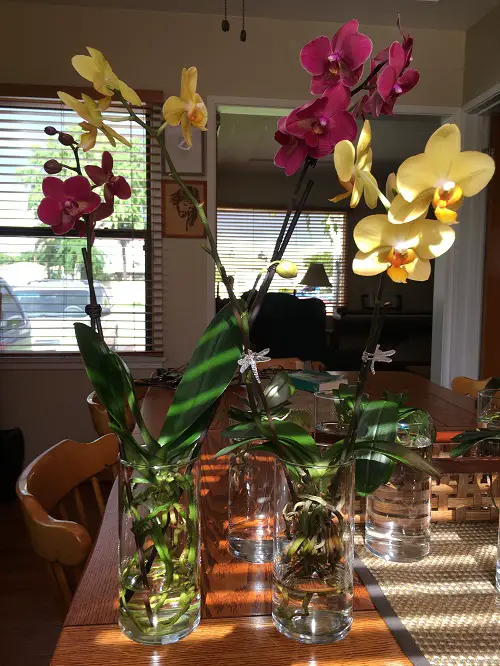
Orchids are the divas of the floral world. With all needs satisfied, they are utterly stunning! And when they effortlessly bloom out of crystal-clear water-filled jars, you know you’ve cracked the ultimate orchid code–water culture!
Why Should You Grow Orchids In Water
Growing orchids in water not only provides you with one of the boldest displays of this popular flowering houseplant but is also easy, affordable, and perfect for the busy gardeners. You save time without worrying about the perfect soil mix, soil-borne diseases, or even a watering schedule!
Perhaps it’s the sun’s rays glistening through a glass vessel or the way its succulent bright green roots slowly form a tangled web for you to see; water-grown orchids are indeed special and worth a try.
Steps to Grow Orchids in Water
1. Select the Right Orchid
While most orchids can adapt to water, some varieties—like Phalaenopsis, Dendrobium, and Oncidium—work better. These cultivars are particularly well-suited for water culture because they thrive in high-humidity environments.
Make sure you pick a fresh and young orchid, as an older one may not be able to adapt to change as quickly or efficiently. Keikis or Orchid babies attached to the stem or base of the mother plant with small roots are also the best candidates for this. Some people recommend using cuttings from “Sympodial Orchids,” but this is not very successful.
If you pick an old orchid for this purpose, don’t forget to remove mature and damaged roots and leaves only the new ones as old roots won’t be able to adapt in the new growing medium.
2. Select the Container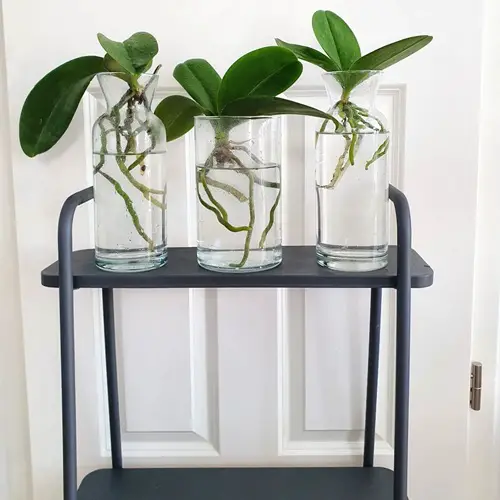
Half the beauty is in the vessel you choose. And the choices you have in are plenty! Just make sure it’s clear and large enough for the plant’s roots to grow.
A transparent container gives you a window into the inner workings of this magical plant and allows you to monitor root growth. Whatever you select, make sure only the roots of your orchid plant are submerged in water. A jar with a narrow neck is perfect for this.
3. Water Quality 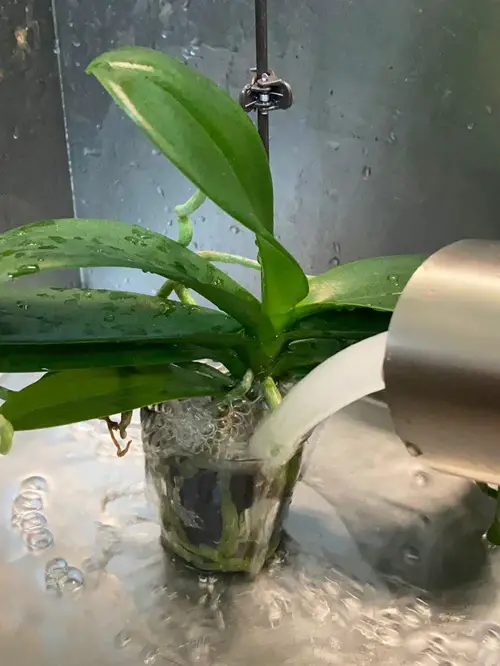
Always use distilled or filtered water for growing orchids. Tap water often contains chemicals and minerals like chlorine and fluoride that can harm the tender roots of the plant over time.
Fill up about two-thirds of your vessel with room-temperature water, and remember to change it every 4-5 days.
4. Preparing the Orchid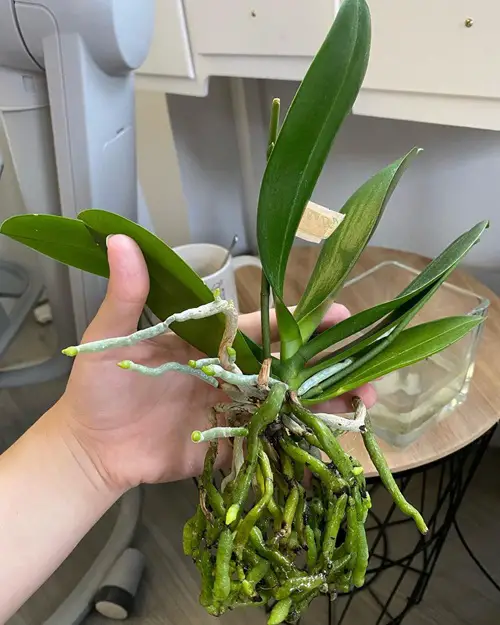
Since nearly 70% of orchids are epiphytes, you’ll easily find a healthy, young one with aerial roots–perfect for water culture. We all know epiphytes are plants that grow on other objects or plants; in this case, they can efficiently absorb moisture and nutrients from the air.
Rinse its roots off all debris and soil with lukewarm water, and trim away old, dead, or mushy roots with sterilized shears, leaving only the fresh and recent ones.
5. Position Your Orchid in Water
Finally, it’s time to seal the deal! Carefully place the orchid in its vessel, ensuring that its roots are fully submerged. However, the base or crown where the leaves and stem meet should always stay above the water.
If there is a problem in positioning it, use cute pebbles to anchor the orchid in place and keep it upright.
Care Tips For Orchids In Water
6. Provide adequate light
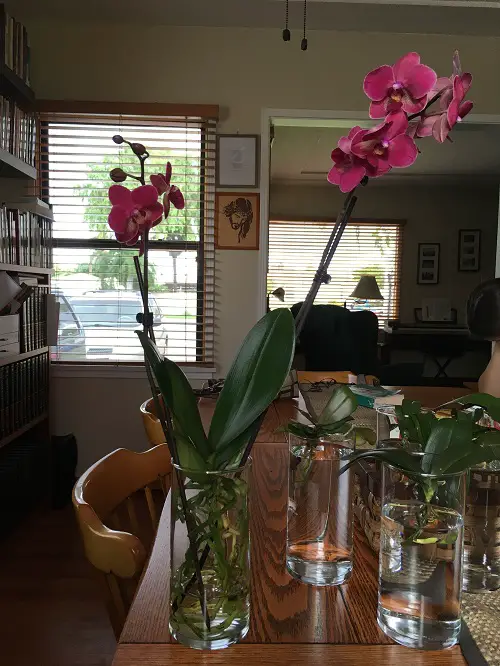
Once your orchid is in water, it’s time to choose a location with bright, indirect light for it.
Remember that water-grown orchids need ample sun to photosynthesize, but their delicate foliage shouldn’t get burnt either. So make sure its resting spot gets filtered or dappled sunlight, like a spot near a west or south-facing window but slightly away if it’s getting full-day direct sunlight.
7. Monitoring the Water
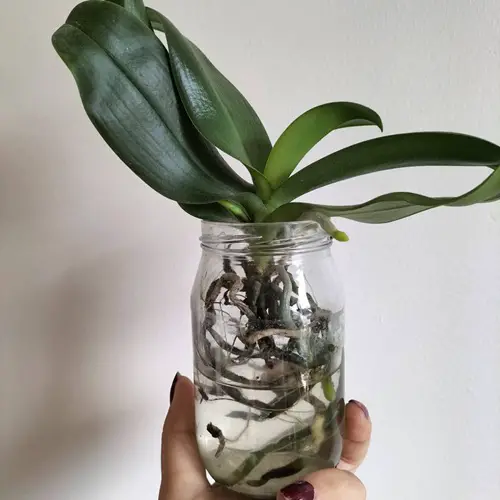
Your orchid vessel can grow algae and bacteria, cutting out oxygen and causing infections. Clean the container thoroughly and regularly and ensure a regular change of water to avoid this.
If there’s too much algae, dilute a drop of hydrogen peroxide solution into fresh water to help control it.
8. Best Fertilizers for Water-Grown Orchids
Fertilizing is not required frequently when growing orchids in water, as they do well without too much interference. Occasionally, using kelp may help with better blooms, reduced stress, and delayed flower abscission.
A balanced, water-soluble fertilizer for any plant growing in water. Add a pinch to the jar with every fourth or fifth water change. These DIY orchid fertilizer recipes will work wonders, so take a look at them as well. You can also use aquarium water for your orchids, as suggested in our article!
Overuse can result in deformed flowers, weak roots, and other undesirable reactions, such as the death of the plant. So use sparingly!
9. Pruning and Changing the Jar
If you find dead, decaying, or mushy roots and brown, wilting leaves, prune them immediately to promote fresh growth and keep your orchids healthy.
Consider moving your orchid to a larger vessel if it is outgrowing the current one or becoming root-bound.
So, this is all about growing a happy orchid in water forever. Try growing it and share your experience in the comments!


